This post comes to you from a lay-by in Bedford, where we are free camping for the night, near the Priory Marina which is also conveniently placed next to one of the town’s recycling stations. Glamorous this journey is not! As I write, I can hear the sounds of a violent disagreement between a couple who are sitting in a neighbouring car, they are swearing fulsomely and sound close to fisticuffs.
It’s surprising how few spots we’ve found where it is actually quiet. Often the noise is obvious: boy racers burning up and down the esplanade in Ryde, police sirens in Margate, the machinations of a scrap metal plant in Oxford (cunningly hidden behind a small coppice) and the planes on the flight path into East Midlands airport from our otherwise tranquil spot on a corner of a farmers field. There’s also the two am sound of drunken voices of revelers on their way home, but most persistent of all is the constant hum of distant traffic. It seems omnipresent, even in small villages which exude the appearance of rustic tranquility. This strikes me not just as a terrible shame, but also as a sign of the way modern life, with its reliance on technology and convenience, continues to erode even the possibility of a calmer, more natural mode of existence.
Â
Posted in MISCELLANEOUS | Comments Off on NOISE POLLUTION
Part of my interest in We English is to explore the layers of history in the landscapes I’m photographing. Take this picture of Holkham Beach, on the north Norfolk coastline, which I took earlier this year. The beach has long been a place of pilgrimage for holiday-makers (it was recently voted best ‘British beach for a bank holiday break’ by readers of The Times). However, when you dig a little deeper, the landscape has not always been one of harmony. And it remains a contested place with different groups laying claim to the landscape.
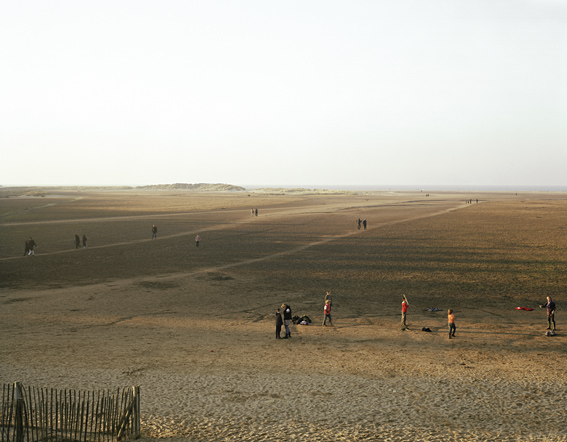
Holkham National Nature Reserve, Norfolk, 18th February 2008
Holkham National Nature Reserve is an extensive reserve on the North Norfolk coastline owned by the Earl of Leicester and the Crown Estates and managed by English Nature and Holkham Estate. As with so much of the English countryside the visual appearance of this stretch of the Norfolk coast is a part wilderness and part constructed landscape. From Burnham Overy to Wells the low-lying marshes north of the coast road used to be tidal saltmarshes, separating offshore shingle and dune ridges from the main coastline. The tidal creeks were large enough to allow ships to load cargo from a staithe at Holkham village. From 1639 onwards a series of embankments were constructed by local landowners, including the Cokes of Holkham. By the time the Wells embankment was completed in 1859 by the 2nd Earl of Leicester about 800 hectares of saltmarsh had been converted to agricultural use. In the late 19th century the 3rd Earl of Leicester planted pine trees on the dunes, creating a shelter-belt to protect the reclaimed farmland from wind-blown sand.
Being close to Sandringham it has also been popular with the Royal Family who occasionally makes visits to their beach hut set back from the dunes. It was particularly popular with the Queen Mother whose own entourage, using the beach back in the thirties, were rumoured to have been responsible for establishing this stretch of sand as a gay beach.
However, the landscape has not always been one of harmony. In the late 1880s, class collisions in East Anglia were most clearly found in areas where people spent their leisure time. While the English understood the codes of behaviour which applied to different social orders in the domestic or work place, these codes were less fixed when people were on holiday. Whole sections of newly mobile classes were likely to meet more often in unpredictable circumstances. The chief attraction of the Norfolk coastline were sports like fishing, shooting sailing and seaside holidays. It was now easy to reach by rail from London, where larger numbers of people had money to spare for holidays. But the numbers and social diversity meant that the middle classes, who were used to distant and uncomplicated relations with the locals, found their holiday-making changed into something much less welcome. Evasion was not always possible, no matter how much it was desired. As John Taylor highlights in his book, A Dream of England, “the fear of class collision meant that the landscape was a place of exclusion and tension, factors deriving from the fascination and repulsion that the middle class felt of the lower classesâ€.
More recently, a moral backlash was sparked when the press were alerted to a campaign by the warden, Ron Harold, to “clean up” the nudist beach popular with local gays. Harold is an employee of English Nature; an organisation ostensibly set up to promote conservation. He declared he would seek a citizen’s arrest on anyone he found cavorting together in the dunes and woods. After a total of five arrests in that first year, Harold erected new signs across the beach prohibiting nudism above the high watermark. The car park prices went up to pay for another warden to assist in the moral policing of the beach.
Posted in LANDSCAPE, REPRESENTATION | Comments Off on LANDSCAPE AS CONTESTED PLACE
During a brief stop in Oxford this weekend I went along to the filming of The Antiques Roadshow at the University’s Hertford College. AR, as it’s affectionately known to its legions of fans, is one of the most popular factual programmes on British television, with an average audience of just under six million. It broadcasts 26 episodes a year coming from locations all over the country.
Â
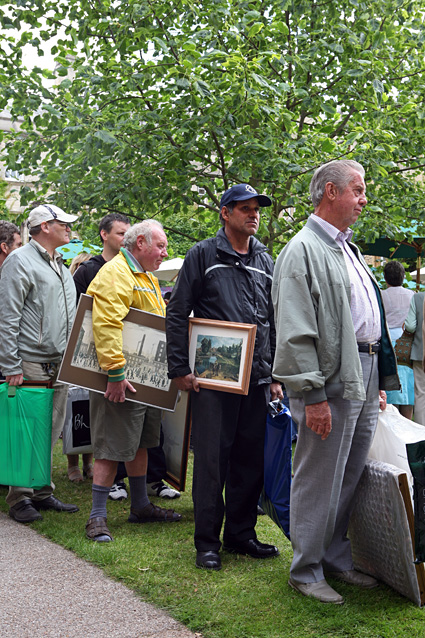
There was a large queue of people hoping to gleen some facts about their family heirlooms and, lets be honest, a valuation, from the resident AR experts. Punters included Lawson, from Oxford, with his print of Constable’s Flatford Mill and John, from Abingdon, with a Lowry.
Â
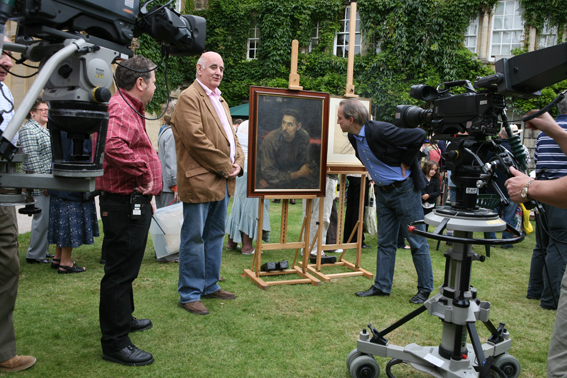
One member of the public, seen above, received slightly better news than Lawson and John. Here AR expert Philip Mould inspects an original sketch by the Russian artist Ilya Repin (dated 1917) which he valued at £200,000, making it one of the most important finds in the programme’s thirty year history!
Â
Posted in EVENTS & PASTIMES | 1 Comment »
The motorhome has done us proud over the past few weeks but it’s time to pull over for a check up. Why? Well we’ve got a leak somewhere, which is starting to seep through the floor and make some funny musty smells! Yesterday, I reversed into a tree which nearly forced the bike rack to penetrate the rear wall and today we had our third flat tyre. Of the four wheel hub caps, we’ve only got one left; one fell off a couple of days ago as we went round a roundabout, the other two simply vanished. Â
Â
Posted in ON THE JOB | Comments Off on IT COMES IN THREES
Continuing my weekly dispatch in The Times, week 5 was taken in Newport, Isle of Wight.
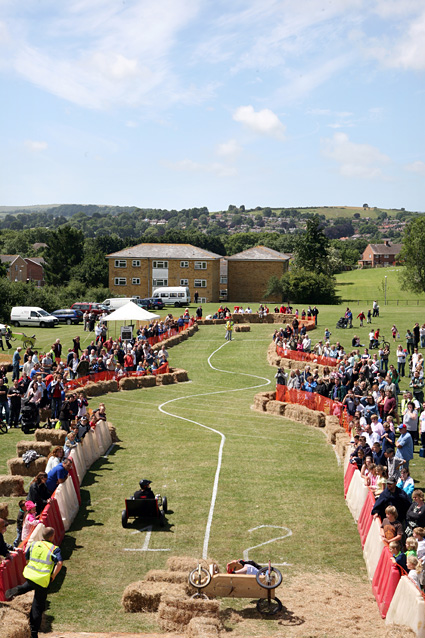
Newport, Sunday 22nd June
A contestant crashes out during the Isle of Wight Soap Box Derby in Newport. The derby is held on a housing estate and organised by a number of local agencies, including the police, as a community-building exercise.
Â
Posted in POSTCARDS | Comments Off on POSTCARD IN THE TIMES – WEEK 5
The Isle of Wight has been making headlines recently with its audacious plans to become the world’s greenest Island. Under the ‘Eco Island’ banner, council leaders are hoping to harness the power of the wind and waves so that by 2013 most of its electricity will come from renewable sources. The bulk will be made up of tidal power, along with on- and perhaps off-shore wind farms. The Island’s ultimate goal is to become completely carbon neutral within a decade and then to produce an excess of renewable energy so they can sell power to the mainland.
Â
Posted in MISCELLANEOUS, PLACES | Comments Off on THE GREENEST ISLAND ON EARTH?
I came across this article on the web by by Jamie Doward, which featured in The Observer back in April. It’s entitled “Murder and arson mar resort’s bid to become a coastal artists’ havenâ€. A ‘hit’ and the torching of a roller-coaster have rekindled memories of a violent past, even as the Margate tries to become Bohemian.
Â
Posted in MISCELLANEOUS | Comments Off on MARGATE POSTSCRIPT
After writing my The Turner Effect blog entry I was reminded of John Taylor’s book A Dream of England. In the book Taylor talks about how the tourist industry uses heritage and draws on poets and novelists to advertise places – Shakespeare Country around Stratford-Upon-Avon (also branded England’s England), Bronte Country in Yorkshire, Hardy Country in Wiltshire and Dorset, Catherine Cookson Country in Tynesdie and Beatrix Potter tourism in the Lake District.
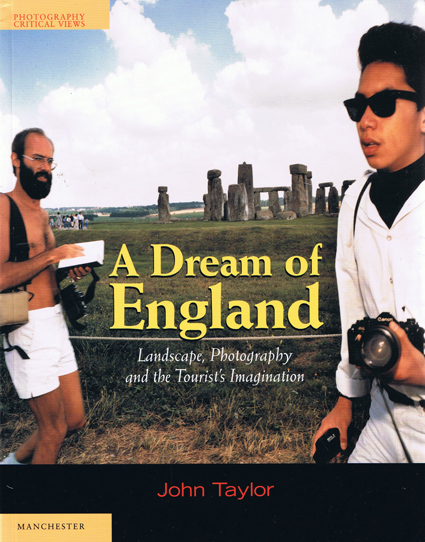
In a chapter titled ‘Pleasures of the Imagination’ Taylor looks at the work of photographers who have adopted a “quizzical stance in relation to the kinds of photographs which tourists produce or which are produced for them in guidebooks.†Photographers who “express doubts about the imagine community of England fashioned in the image of the dominant white middle class.†Taylor terms these individuals, ‘oppositional photographers’, and he includes bodies of work by Martin Parr (Cost of Living), John Kippin (ENGLISHISTORY), Karen Knorr (Monks of Disfunction), Ingrid Pollard (Pastoral Interludes) and Paul Reas (Flogging a Dead Horse).
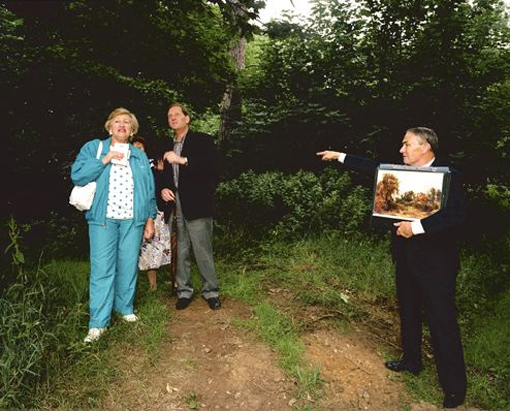
© Paul Reas
In Flogging A Dead Horse, Paul Reas photographs the tour guide who carries a reproduction of Constable’s original Flatford Mill painting and is seen indicating the area which Constable actually painted, thereby overcoming the tourists fear of failing to see the desired spot. Reas’ work is a biting criticism of the heritage industry, an industry which Taylor suggests “represents a break with a politicsed and complex historical appreciation of contemporary English life.†Heavyweights such as English Heritage and National Trust use entertainment to display history, but a sanitized version which is just a representation of the past, clinical and doesn’t present contradictions or context.
You can see more of Reas’ work from Flogging a Dead Horse (Pub: Cornerhouse/Arts Council, UK 1993) here.
Posted in OTHER STUDIES, RESEARCH | Comments Off on HERITAGE INDUSTRY
Having frequented countless Tourist Information centres in towns and cities over the past few months, it’s fascinating to see how places market themselves in the hope of attracting tourists. From Broadstairs’ use of Dickens (see my last post) and Suffolk branding itself as Constable Country to the Lake District embracing Wordsworth to Stratford-Upon-Avon employing the strapline “Explore England’s England†(along with Shakespeare Country of course).
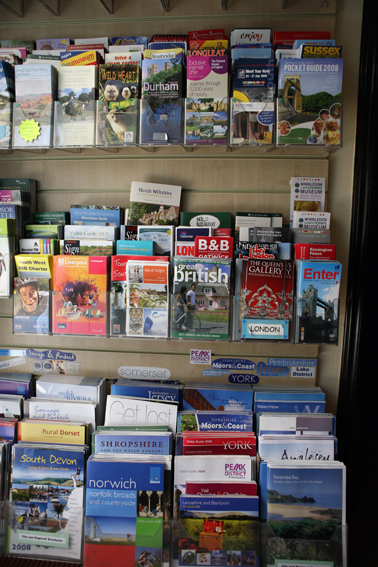
This issue of how places represent and brand themselves is something I’ll come back to in a later post, but for the time being I just wanted to talk about Margate, the coastal town in Thanet which has become a by-word for rundown seaside resorts and whose recent decline was immortalized in Pawel Pawlikowski’s stark film Last Resort (2000).
Margate has an important place in the story of seaside holidays. It vies with Scarborough, Whitby and Brighton for the title of England’s first seaside resort. Since the early 18th century, people have been visiting the town to bathe in the sea, first for health reasons, then for pleasure as it became a playground for some of the wealthiest members of London society. With the arrival of railways, visitors who had been restricted to traveling along the Thames could now explore stretches of cast further afield. However, by the eve of the First World War, Margate was as busy as any resort. The town’s small-scale facilities were soon replaced by large hotels and new forms of entertainment for the hundreds of thousands of Georgian holidaymakers who arrived each year.
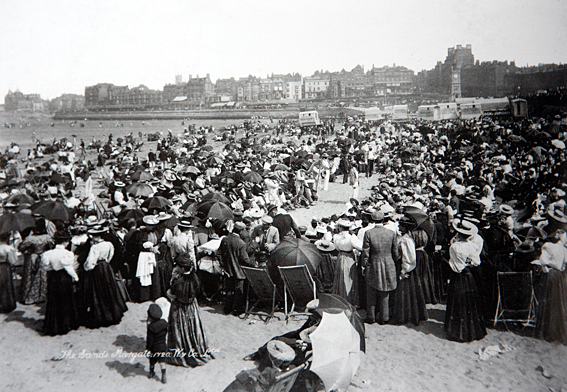
Margate’s sandy beach with a large group of summer trippers entertained by a minstrel show, 1890s.
The prosperity of the seaside continued until the 1960s,but with growing leisure time, increased disposable income and easy access to foreign holidays, all seaside resorts suffered decline, though none has probably suffered as much as Margate. The town has experience a vicious circle, with decreasing visitor numbers leading to reduced investment and consequently poorer facilities that again attract fewer holidaymakers.
However, it seems Margate has hit upon a plan for renewal which might just help it return it to some of its past glory. The town, along with Thanet and Kent County Council, is turning to art as a vehicle for regeneration and enlisting the help of our most influential painters, no not local bad-girl Tracy Emin (although she is proving quite influential), but rather JMW Turner.
Turner (1775-1851) was a regular visitor to Margate throughout his life, drawn by the quality of the light. He once remarked that ‘the skies over Thanet are the loveliest in all Europe’.
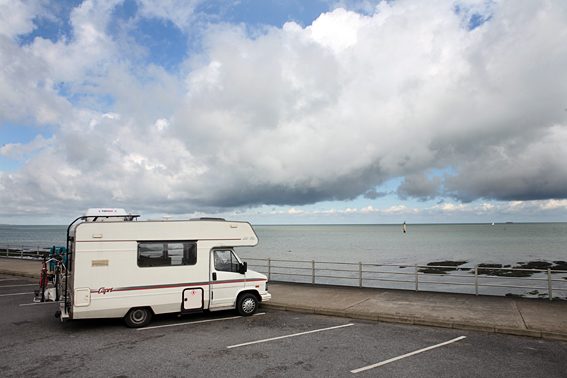
My attempt at a Turner sky, looking out onto the English Channel from our parking space on Margate’s seafront.
The Turner Contemporary gallery has recently received planning permission for a building designed by 2007 RIBA Stirling Prize winner David Chipperfield Architects. Work is expected to start on site (which is situated a few hundred meters from the picture above) in autumn 2008 ahead of the gallery opening in 2010. The successful operation of the gallery is seen as playing a key role in the regeneration of Margate’s eastern seafront and the reinvention of the old town as an artistic quarter.
As you walk around the town there are obvious signs of change. Many of the rundown buildings I’d seen on my last visit here five years ago are being turned into cafes and restaurants (thankfully few of them major chains) and there are already obvious signs that art is playing an important role with a number of community arts projects and workshops springing up around the town. The old site of M&S on Margate’s highstreet is currently housing off site projects for the Turner Contemporary until its opening in 2010.
It is unlikely Margate will ever attract the vast numbers of visitors that flocked there in the 19th and early 20th centuries. However, with growing concerns about the environmental effects of flying and the costs of foreign travel, the English seaside holiday may enjoy some form of revival.
For those of you interested in the topic of representation within the tourism industry, there’s a quarterly journal called Tourism Geographies: An International Journal of Tourism Space, Place and Environment, published by Routledge.
This paper looks particularly interesting-
Tourism consumption and tourist behaviour: a British perspective by Gareth Shaw a;Â Sheela Agarwal b; Paul Bull c
| Affiliations: |
a Department of Geography, University of Exeter, UK. |
|
b Centre for Tourism, Sheffield Hallam University, UK. |
|
c Department of Geography, Birkbeck College, University of London, UK. |
DOI: 10.1080/14616680050082526
Publication Frequency: 4 issues per year
Published in: Volume
2, Issue
3 August 2000 , pages 264 – 289
Order it here.
Posted in REPRESENTATION | 1 Comment »
Continuing my weekly dispatch in The Times, week 4 was taken in Broadstairs, Kent.
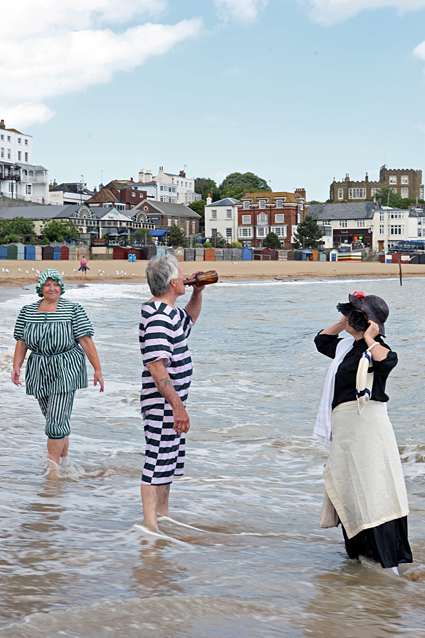
Broadstairs, Thursday June 19th
Members of the Dickens Society, clad in Victorian swimwear, take a dip in the English Channel after the official opening of the Broadstairs Dickens Festival. Charles Dickens visited Broadstairs regularly from 1837 until 1859 and immortalised the town as “our English watering place.”
Â
Posted in POSTCARDS | Comments Off on POSTCARD IN THE TIMES – WEEK 4











